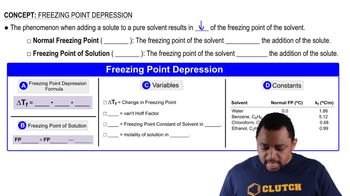Here are the essential concepts you must grasp in order to answer the question correctly.
Freezing Point Depression
Freezing point depression is a colligative property that describes the lowering of a solvent's freezing point when a solute is added. The extent of this depression is directly proportional to the number of solute particles in the solution. The formula used to calculate freezing point depression is ΔTf = Kf * m, where ΔTf is the change in freezing point, Kf is the freezing point depression constant of the solvent, and m is the molality of the solution.
Recommended video:
Freezing Point Depression
Molecular Weight Calculation
Molecular weight, or molar mass, is the mass of one mole of a substance, typically expressed in grams per mole (g/mol). To determine the molecular weight of a compound, one must first find the number of moles of solute using the freezing point depression data and the known Kf value. Once the moles are calculated, the molecular weight can be found by dividing the mass of the solute by the number of moles.
Recommended video:
Molecular Formula Calculation Example
Empirical and Molecular Formulas
The empirical formula represents the simplest whole-number ratio of elements in a compound, while the molecular formula indicates the actual number of atoms of each element in a molecule. To derive the molecular formula from the empirical formula, one must determine the molar mass of the compound and compare it to the molar mass of the empirical formula. This comparison helps in identifying the factor by which the empirical formula must be multiplied to obtain the molecular formula.
Recommended video:
Empirical vs Molecular Formula
 Verified step by step guidance
Verified step by step guidance


